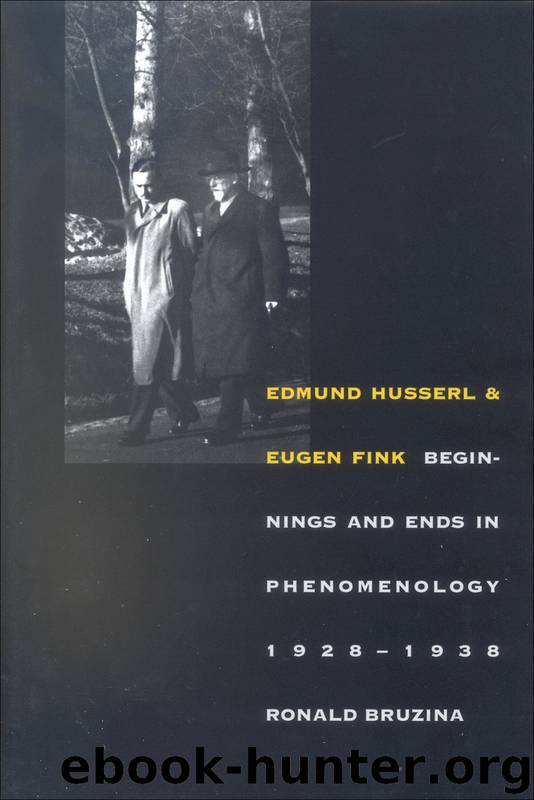Edmund Husserl and Eugen Fink by Bruzina Ronald

Author:Bruzina, Ronald.
Language: eng
Format: epub
Publisher: Yale University Press
Published: 2004-04-14T16:00:00+00:00
5.2.3.2. The I as Wakefulness in the Horizonality of Depresencing
Husserl’s move to explicate primordial temporality as the egoic living present, thus giving a structural characterization for both the ultimate transcendental I and the originating power of temporalization, was meant to be a move of final clarification, of final disclosure of . For Fink, however, it was more critically correct to take temporality as primarily horizonal; for depresencing was the more radical function of temporalization, the coming-about of the temporal as such (5.1.1); and the correlate in human consciousness to this primordial originative dynamism was not an I-center for action but the pre-egoic openness to the horizonal as such, namely, wakefulness. (See 5.1.2.3.3.)
279. See Z-XV 91a, 111a, and 117a; EFM 2. Again, it is not the presentness of presencing that is the dynamic factor in the coming-about of temporality but rather de-presencing.
280. Fink’s Louvain “Report” of 1939, EFM 4, Abschn. 4. See also Z-XXVII XIX/2a (#5), EFM 3, from a conversation with Landgrebe, January 14, 1940. See also Fink’s late general statement of the limitations of the schemata that Husserl’s analyses followed in his classic description of phenomena, ND, pp. 320–22.
281. Z-II 35b, EFM 1.
Reducing the inappropriateness of conceptualization for primordial temporalization meant moving as far as possible regressively along intra-temporal structuring not only by “de-presentializing” but also “de-egoizing” the findings.282
Wakefulness is not an intentionality of doing, it is more like an intentionality of being—if one would retain the term intentionality. Correspondingly, it is not an intentionality thematically aimed at a specific goal but rather precisely a non-specific and non-directed “intentionality,” namely, global openness to fundamental horizonality as such rather than to any kind of objective something. Such is the conception Fink proposed. For Husserl, wakefulness frequently comes up in the C-manuscript analyses, but always as subordinated to thematic act-intentionality.283 Yet Husserl is worried about it. “The whole of what exists for me [das ganze Für-mich-sein] as human, as person in the world, comes out of wakefulness,” he writes in one lengthy manuscript;284 and wakefulness is an encompassing condition that has to be brought into consideration when the activity of wakeful subjectivity is explicated as constitution. But wakefulness is understood by Husserl as the period of the possibility of activity on the part of an agent-ego, so that wakefulness, along with birth and death, seems somehow to mark beginning and ending in the life of transcendental constitutive action. Granting, however, Husserl’s posing this activity of constitution in terms of a plurality of subject-centers—“transcendentally the world is the constitutive product of transcendentally wakeful subjects as persons standing together in wakeful association in a unity of tradition,” he writes—still he has to ask how one makes intelligible the idea of the “new entry of transcendental subjects on the scene and then their disappearance.”285
Here is where Husserl introduces a slight inflection in the identification of the transcendental I with the living present.
282. “The de-egoizing of egoity (absolution) is not attainable by a mundane annihilation of the I, but rather by a radicalization of egoity.” And Fink adds: “Thus too de-temporalization.
Download
This site does not store any files on its server. We only index and link to content provided by other sites. Please contact the content providers to delete copyright contents if any and email us, we'll remove relevant links or contents immediately.
The remains of the day by Kazuo Ishiguro(8814)
Tools of Titans by Timothy Ferriss(8211)
Giovanni's Room by James Baldwin(7187)
The Black Swan by Nassim Nicholas Taleb(7009)
Inner Engineering: A Yogi's Guide to Joy by Sadhguru(6722)
The Way of Zen by Alan W. Watts(6501)
Asking the Right Questions: A Guide to Critical Thinking by M. Neil Browne & Stuart M. Keeley(5627)
The Power of Now: A Guide to Spiritual Enlightenment by Eckhart Tolle(5602)
The Six Wives Of Henry VIII (WOMEN IN HISTORY) by Fraser Antonia(5394)
Astrophysics for People in a Hurry by Neil DeGrasse Tyson(5130)
Housekeeping by Marilynne Robinson(4328)
12 Rules for Life by Jordan B. Peterson(4249)
Double Down (Diary of a Wimpy Kid Book 11) by Jeff Kinney(4204)
The Ethical Slut by Janet W. Hardy(4172)
Skin in the Game by Nassim Nicholas Taleb(4160)
Ikigai by Héctor García & Francesc Miralles(4123)
The Art of Happiness by The Dalai Lama(4063)
Skin in the Game: Hidden Asymmetries in Daily Life by Nassim Nicholas Taleb(3929)
Walking by Henry David Thoreau(3892)
